第七章 回交育种要点
- 格式:ppt
- 大小:2.51 MB
- 文档页数:50
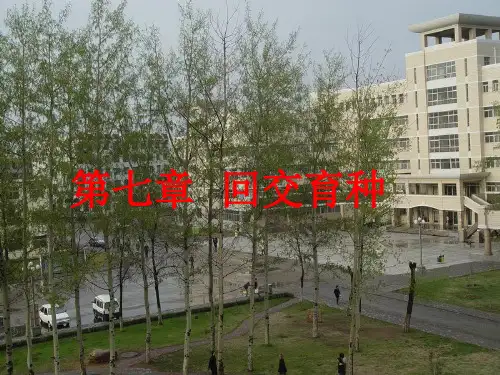
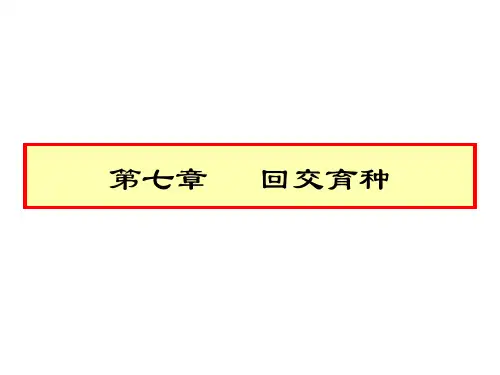
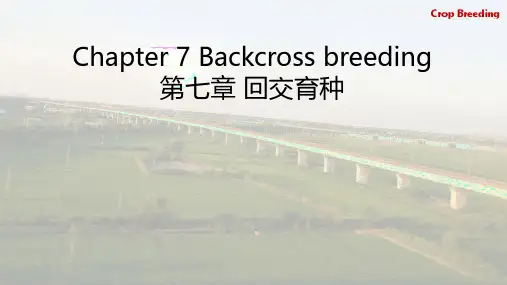
第七章 回交育种7.1 The significance and genetic effect ofbackcross breedingConceptConceptConcept•Backcross•Backcross breeding:•the method of introducing thetarget traits of the donor intothe recipient through one or [ (A×B)×A ]×A ......more backcrossesConcept Concept Concept•Recurrent parent:•Parents used for multiplebackcrossing are called Recurrent parents •Non-recurrent parent:•Parents used only in the firsthybridization are called non-recurrent parents[ (A×B)×A ]×A ......Recurrent parent Non-recurrent parentConcept Concept Concept•Receptor parents:•Accepts favorable traits (target traits)•Donor parent:•provides of target traits•1) recovery of recurrent parent (selection of recurrent parent is critical) – Forward selection•2) incorporate a new trait from the donor parent-BackgroundThe significance of backcross breeding•Backcross breeding is the most effective method for improvingmaterials with good comprehensive traits but few unfavorabletraits, especially the unfavorable traits have high heritability(quality traits or main effect QTL)•Backcross breeding can effectively overcome the problems ofhybrid sterility and too long separation period in wide-crossbreeding•Backcrossing helps to break the genetic linkage dragGenetic effects of backcrossing•The genotype homozygous rate of backcross offspring was consistent with that of self-cross; ex: BC4, (25-1)/25 = 31/32 or 96.875%•The homozygous genotype of backcrossing offspring is controlled by the recurrent parent and is not completely consistent with thehomozygous direction of self-crossing offspring•Backcross is conducive to eliminate the probability of linkage drags7.2 Key points of backcross breedingSteps of the key pointsThe selection for the parentsThe selection for the offspringThe number of backcrossesperformed7.2.1 The selection for the parents•Recurrent parents:üHave good comprehensive traits üHave expected utilization value •Non-recurrent parents:üProvide target genesüNo serious shortcomings7.2.2 The selection for the offspringsBackcross and transfer of qualitative traits :ØTrait transfer controlled by a pair of dominant genesØTrait transfer controlled by a pair of recessive genesØTransfer of a dominant gene is accomplished more readily than arecessive gene Backcross transfer of quantitative traits ØPolygene; it takes long timeØDue to the influence of environment, progeny test is necessary, and sometraits need to create favorableenvironments for identificationØIncrease the population size to ensure that each backcross generation canappear the target genotypesØCombined with marker-assisted selectionTransfer of a dominant gene using backcrossing.Source: Stoskopf, 1993.Plant Breeding Theoryand Practice.Transfer of a recessive gene using backcrossingSource: Stoskopf, 1993.Plant Breeding Theory andPractice.7.2.3 The number of backcrosses performedØThe importance of recovering the traits of the recurrent parent ØThe number of selected plants during backcrossingØThe similarity between the recurrent and donor parentsØLinkage drags between desirable and undesirable genes7.3 The methods derived from backcross breedingFour main methods of backcrossingStepwise backcrossing Pedigree backcrossingDouble backcrossing Convergent backcrossing7.3.1 Stepwise backcrossingØWhen the target traits come from different donors, the backcross between the recipient parents and different donors can be carried out step by step, which is called stepwise backcrossing method.7.3.2 Pedigree backcrossingØIn order to enlarge the genetic influence of a parent on hybrid offspring, the parents and hybrid offspring can be backcrossed 1-2 times, and then the breeding can be continued by genealogyØIncomplete backcrossing of 1-2 times is also called limitedbackcrossing method7.3.3 Double backcrossingØWhen two parental inbred lines A and B of A superior singlecross A/B have better comprehensive traits and combining ability, but each has different defectsØThe defect of A can be overcome by B, and the defect of B can be overcome by A7.3.4 Convergent backcrossingØWhen the target traits come from more donors, the modified varieties and multiple donors can be backcrossed for several generations at the same time, and then the improved lines with the unique excellent traits of each donor parent can be selected and bred by multiple-hybridizations7.4 The characteristics and application of backcross breedingAdvantages of Backcross BreedingØPredictable - traits of the recurrent parent are recovered with one new trait introgressed.ØAn existing cultivar can be improved without risk of breaking up desirable gene combinations.ØThe location where the backcrossing procedure is conducted is independent of the area of adaptation.ØLess testing is required prior to releaseDisadvantages of Backcross BreedingØThere is no possibility of a desirable new recombination of traitsØNot useful in quantitatively inherited traits such as horizontal disease resistanceØLinkage drags may reduce the recovery of the recurrent parentgenotypeOther uses for backcrossingüDevelopment of isogenic lines or isolines or near-isogenic lines(lines differing from one another for only one trait)üBreeding multi-line varietiesüDevelopment of cytoplasmic male sterile lines1) Backcrossing “transgenes” into different backgrounds.2) Molecular markers are used to assist in backcrossing in TWO ways- to select for the gene of interest- to select plants with the least amount of DNA from the donor parent. (Markers spaced out over the entire genome)。

第七章回交育种
一学时数:2
二教学目标:
使学生了解回交的遗传效应和回交育种步骤;重点掌握显性单基因、隐性单基因目标性状回交转育的工作内容;回交的用途。
三教学重点:显性单基因、隐性单基因目标性状回交转育的步骤
四教学难点:回交的遗传效应
五教学内容及教学过程:
1.复习杂交育种重点内容,导入新课,讲述回交育种的概念;以及轮回亲本和非轮回亲本、供体亲本与受体亲本的概念;回交育种的应用条件。
10min.
2. 利用公式、表格讲述回交的遗传效应:轮回亲本的基因频率逐渐增加,非轮回亲本的基因频率逐渐减少;回交后代达到一种纯合基因型的速度更快;可以更有效地打破不利基因的连锁。
10min.
3.讲述回交育种工作包括杂交、回交、选株连续回交、自交稳定和产量比较五个环节的基础上,分别讲述与回交育种过程相关的轮回亲本、非轮回亲本的选择指标;回交的次数;回交所需的植株数等问题。
20min.
4. 结合回交育种程序,讲述显性单基因和隐性单基因控制性状的回交转育步骤;比较两类性状回交转移步骤地异同。
20min.
5. 明确对多个目标性状的导入可采用逐步回交和聚合回交的方法,图示说明聚合回交的两种策略。
15min.
6. 通过与杂交育种的对比,总结回交育种的优势和局限性。
10min.
7. 阐述回交的用途,除了用于改良品种的个别缺点的作用外,还可用于近等基因系的培育、雄性不育系的转育和克服远缘杂交困难等方面。
13min.
8. 小结,布置思考题。
2min.。
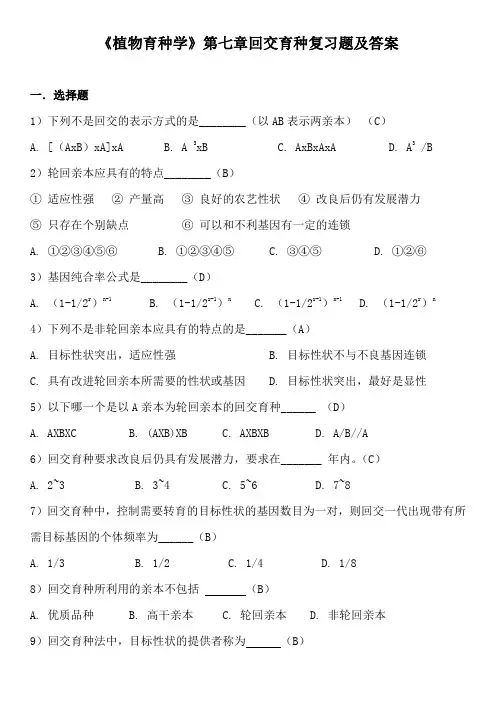
《植物育种学》第七章回交育种复习题及答案一.选择题1)下列不是回交的表示方式的是________(以AB表示两亲本)(C)A. [(AxB)xA]xAB. A 3xBC. AxBxAxAD. A3 /B2)轮回亲本应具有的特点________(B)①适应性强②产量高③良好的农艺性状④改良后仍有发展潜力⑤只存在个别缺点⑥可以和不利基因有一定的连锁A. ①②③④⑤⑥B. ①②③④⑤C. ③④⑤D. ①②⑥3)基因纯合率公式是________(D)A. (1-1/2r)n-1B. (1-1/2r-1)nC. (1-1/2r-1)n-1D. (1-1/2r)n4)下列不是非轮回亲本应具有的特点的是_______(A)A. 目标性状突出,适应性强B. 目标性状不与不良基因连锁C. 具有改进轮回亲本所需要的性状或基因D. 目标性状突出,最好是显性5)以下哪一个是以A亲本为轮回亲本的回交育种______ (D)A. AXBXCB. (AXB)XBC. AXBXBD. A/B//A6)回交育种要求改良后仍具有发展潜力,要求在_______ 年内。
(C)A. 2~3B. 3~4C. 5~6D. 7~87)回交育种中,控制需要转育的目标性状的基因数目为一对,则回交一代出现带有所需目标基因的个体频率为______(B)A. 1/3B. 1/2C. 1/4D. 1/88)回交育种所利用的亲本不包括(B)A. 优质品种B. 高干亲本C. 轮回亲本D. 非轮回亲本9)回交育种法中,目标性状的提供者称为(B)A. 轮回亲本B. 非轮回亲本C. 母本D. 父本10)回交育种法中,目标性状的接受者者称为(A)A. 轮回亲本B. 非轮回亲本C. 母本D. 父本11)既可以保持亲本基本性状,有可以添加特定的目标性状,再通过筛选而培育出新品种的育种方法是(C)A. 引种B. 杂交育种C. 回交育种D. 诱变育种12)回交育种中,无论回交次数多少,最后都得(D)A. 杂交B. 测交C. 选择D.自交13)回交后代的杂种群体已具有目标性状与轮回亲本优良性状基本相似时,为选择显性性状纯合个体,需自交次;隐性性状纯合个体需自交次(B)A. 1 , 1B. 2 ,1C. 1 ,2D. 2 ,214)回交育种法可以在、加代中进行回交和选择,缩短育种年限。
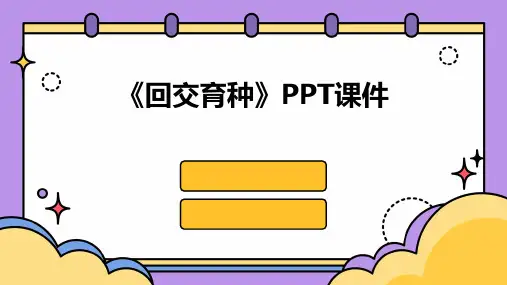
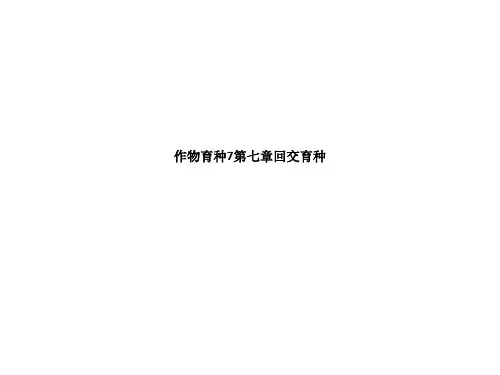
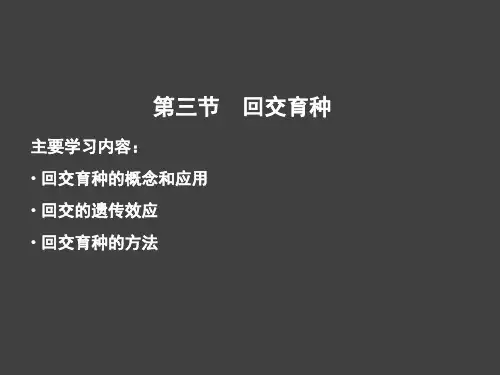
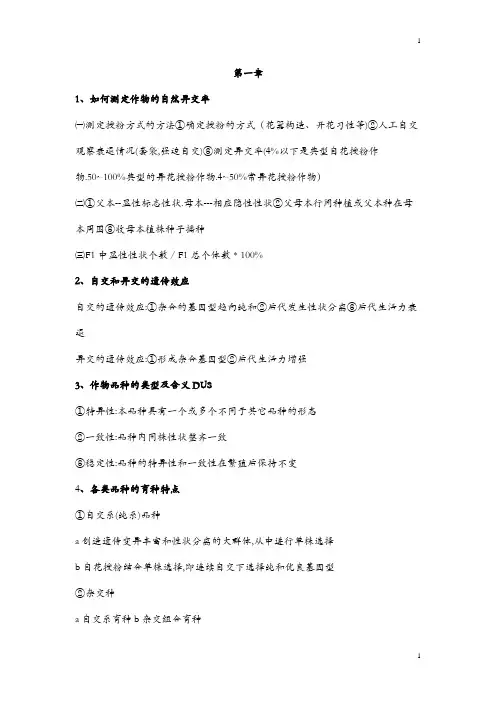
第一章1、如何测定作物的自然异交率㈠测定授粉方式的方法①确定授粉的方式(花器构造、开花习性等)②人工自交观察衰退情况(套袋,强迫自交)③测定异交率(4%以下是典型自花授粉作物.50~100%典型的异花授粉作物.4~50%常异花授粉作物)㈡①父本--显性标志性状.母本---相应隐性性状②父母本行间种植或父本种在母本周围③收母本植株种子播种㈢F1中显性性状个数∕F1总个体数﹡100%2、自交和异交的遗传效应自交的遗传效应:①杂合的基因型趋向纯和②后代发生性状分离③后代生活力衰退异交的遗传效应:①形成杂合基因型②后代生活力增强3、作物品种的类型及含义DUS①特异性:本品种具有一个或多个不同于其它品种的形态②一致性:品种内同株性状整齐一致③稳定性:品种的特异性和一致性在繁殖后保持不变4、各类品种的育种特点①自交系(纯系)品种a创造遗传变异丰富和性状分离的大群体,从中进行单株选择b自花授粉结合单株选择,即连续自交下选择纯和优良基因型②杂交种a自交系育种b杂交组合育种③群体品种a对后代群体一般不进行单株选择b保持较大的随即样本群体,多代自由授粉下积累有益基因改良群体④无性系品种a有性杂交+无性繁殖b利用芽变5、.不同授粉方式作物的遗传特点及育种方法(一)自花授粉作物:如水稻、小麦、大麦、燕麦、大豆、绿豆、豌豆、花生、异交率为0~4%。
花器构造特点①是两性花, 雌雄蕊同花、同熟,二者长度接近或雄蕊较长;②开花时间较短,甚至闭花授粉;③花器保护严密,其他花粉不易飞入。
遗传特点:⑴个体基因型纯合⑵群体内基因型单一⑶群体内个体之间表现型整齐一致(4)遗传稳定育种与良繁方法:⑴利用自然变异和天然异交⑵人工强迫异交与单株选择相结合------杂交育种⑶人工强迫异交-------杂优利用(不易去雄)⑷良繁时隔离距离要求不严格,适当隔离。
(二) 异花授粉作物:异交率>50%,甚至高达95%或100%。
代表作物:玉米,大麻,菠菜,黄瓜,甘薯等。
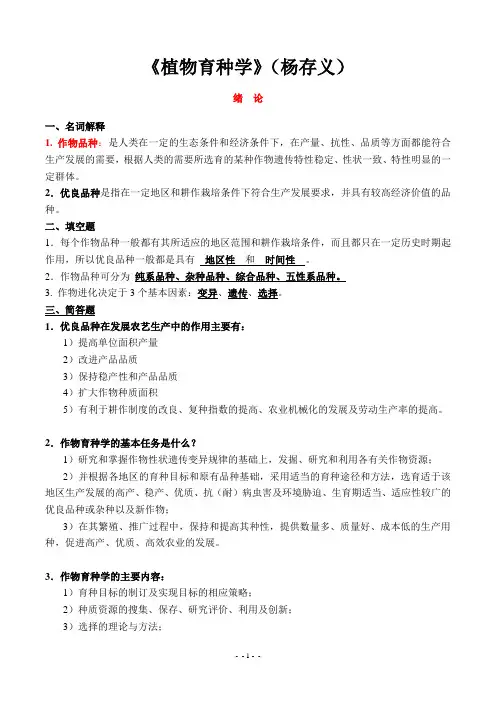
《植物育种学》(杨存义)绪论一、名词解释1. 作物品种:是人类在一定的生态条件和经济条件下,在产量、抗性、品质等方面都能符合生产发展的需要,根据人类的需要所选育的某种作物遗传特性稳定、性状一致、特性明显的一定群体。
2.优良品种是指在一定地区和耕作栽培条件下符合生产发展要求,并具有较高经济价值的品种。
二、填空题1.每个作物品种一般都有其所适应的地区范围和耕作栽培条件,而且都只在一定历史时期起作用,所以优良品种一般都是具有地区性和时间性。
2.作物品种可分为纯系品种、杂种品种、综合品种、五性系品种。
3. 作物进化决定于3个基本因素:变异、遗传、选择。
三、简答题1.优良品种在发展农艺生产中的作用主要有:1)提高单位面积产量2)改进产品品质3)保持稳产性和产品品质4)扩大作物种质面积5)有利于耕作制度的改良、复种指数的提高、农业机械化的发展及劳动生产率的提高。
2.作物育种学的基本任务是什么?1)研究和掌握作物性状遗传变异规律的基础上,发掘、研究和利用各有关作物资源;2)并根据各地区的育种目标和原有品种基础,采用适当的育种途径和方法,选育适于该地区生产发展的高产、稳产、优质、抗(耐)病虫害及环境胁迫、生育期适当、适应性较广的优良品种或杂种以及新作物;3)在其繁殖、推广过程中,保持和提高其种性,提供数量多、质量好、成本低的生产用种,促进高产、优质、高效农业的发展。
3.作物育种学的主要内容:1)育种目标的制订及实现目标的相应策略;2)种质资源的搜集、保存、研究评价、利用及创新;3)选择的理论与方法;4)人工创造变异的途径、方法和技术;5)杂种优势利用的途径和方法;6)目标性状的遗传、鉴定及选育方法;7)作物育种各阶段的田间实验技术;8)新品种的审定、推广和种子生产。
4.现代作物育种的发展动向主要表现在以下几方面:1)育种目标要求要高。
现代农业对新品种不仅要求进一步提高单产潜力,增强对多种病虫害及环境胁迫的抗耐性,广泛的适应性;而且还要求具有优良的产品品质和适应机械操作的特性等。
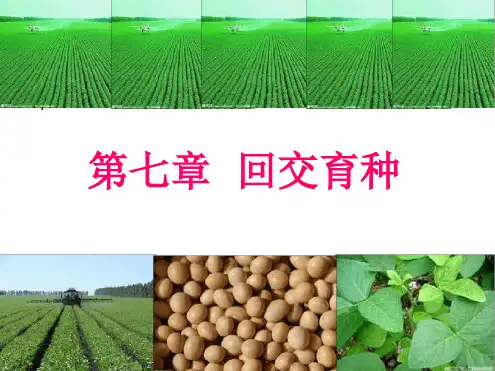
第七章总结一、名词解释:杂交:指遗传类型不同的生物体相互交配或结合而产生杂种的过程。
按杂交是否通过性器官分为有性杂交和无性杂交;按杂交亲本亲缘关系分为远缘杂交和近缘杂交;按杂交机理及后代影响分为组合育种和优势育种。
杂交育种:通过杂交途径培育新品种。
优势利用(♀自交系×♂自交系)→F1(杂种)利用,F2衰退,先纯后杂;杂交育种(甲×乙)→杂交种自交→选择新品种,遗传稳定,先杂后纯。
近缘杂交:指不存在杂交障碍的同一物种内,不同品种或变种之间的杂交。
远缘杂交:指植物学上不同种、属以上类型间的杂交。
常规杂交育种:又称组合育种,重组育种。
通过人工杂交,把分散在不同亲本上的优良性状组合到杂种中,对其后代进行多代培育选择,比较鉴定,以获得遗传相对稳定,具有栽培利用价值的定型新品种的一种育种途径。
单交:杂交亲本为两个,又称成对杂交。
回交:杂种第一代及其以后世代与其亲本之一进行杂交称之为回交只参加一次杂交的亲本为非轮回亲本,参加多次回交的亲本为轮回亲本.添加杂交:多个亲本本逐个参与杂交的叫添加杂交。
合成杂交:参加杂交的亲本先两两单交,然后两个单交种再杂交。
多父本授粉:用一个以上父本品种的混合花粉授给一个母本品种的方式称多父本授粉。
多亲交配:又称复合杂交,复交;多个(3 个或3 个以上)亲本参与杂交亲本选择:指根据育种目标选用哪些品种类型作为杂交亲本。
亲本间优缺点互补:指亲本间若干优良性状综合起来应能够满足育种目标的要求,一方的优点能在很大程度上克服对方的缺点。
亲本选配:指从入选亲本中选用哪两个(几个)亲本组配杂交以及采用何种组配方式。
去雄: 即除去雄蕊的花,准备人工杂交授粉的技术措施。
标记: 在生物化学、分子生物学领域为了识别而对分子作的记号。
常用的标记物质有放射性或稳定性核素、生物素、酶类、荧光素、地高辛精等。
杂交: 两条单链DNA或RNA的碱基配对。
遗传学中经典的也是常用的实验方法。
通过不同的基因型的个体之间的交配而取得某些双亲基因重新组合的个体的方法。
回交育种第六节回交育种⼀、回交育种的意义及其特点(⼀) 回交育种的意义1、回交育种概念把供体的⽬标性状通过回交导⼊受体的育种⽅法称为回交育种。
轮回亲本综合性状(也称背景性状,background character)优良,但尚⽋缺⼀两个有利性状,⾮轮回亲本恰好具备这⼀两个有利性状。
这⼀两个有利性状称为⽬标性状(Target character)。
2、回交育种的意义①控制杂种群体,精确地改良品种;提⾼优良品种的抗逆性、抗病性②雄性不育转育(⾃然发现或⼈⼯诱变的不育株往往经济性状不良或配合⼒低,利⽤回交转育法可将不育基因转移到优良品种后来,育成不育系)。
③克服远缘杂交的困难(不实性),创造新种质④改善杂交材料性状(给杂交亲本转移苗期标志性状)(⼆)回交育种的特点1、回交育种的有利性(1)性状的遗传变异易于控制。
在各种育种⽅法中,回交育种的预见性最强。
(2)只要回交后代的⽬标性状能充分表现,在任何环境条件下都可开展回交育种。
这为利⽤温室及异地异季加代提供了便利条件。
另⼀⽅⾯,回交后代群体所包含的基因型种类远远少于杂种⾃交后代群体中的基因型种类,所以回交后代所需群体的容量较⼩,从⽽有利于缩短育种年限。
(3) ⽬标性状的选择易于操作。
回交育种⼀般只需将其农艺性状与轮回亲本⽐较;⽬标性状与⾮轮回亲本⽐较,其⽐较鉴定所需的时间较短。
育成品种的特征特性⼀经肯定,便可在⽣产上应⽤。
(4) 育成品种易于推⼴。
2、回交育种的局限性(1) 只能改良个别缺点;(2) 限于主基因控制的⽬标性状。
如果控制⽬标性状的基因对数较多,在回交后代中选株回交的难度较⼤。
(3) ⽬标性状的遗传⼒较低时,难于鉴定识别,不易获得较好的改良效果。
(4) 回交的每⼀世代都要进⾏较⼤数量的杂交,⼯作量⼤。
⼆、回交的遗传效应1、受体和供体遗传物质在回交后代中所占的⽐例对背景性状⽽⾔,每回交⼀次,由受体导⼊回交后代的有利遗传物质较上代增加⼀半,⽽来⾃供体的不利遗传物质较上代减少⼀半。
园艺专业遗传育种学--网上教学课程第一篇:园艺专业遗传育种学--网上教学课程第七章杂交育种、回交育种、远缘杂交及倍性育种这一章内容比较多,重点是要求掌握杂交育种中亲本选配原则,杂交方式、杂种后代处理方法和育种程序。
但是对远缘杂交、倍性育种也要有所了解,因为这些育种方法的成果也是很大的。
其实这几种育种方法,基础还是杂交,只不过亲本不一样,因而产生的问题和要注意的方面不一样。
一般我们所说的杂交育种就是种内不同品种的杂交。
而回交育种是一种特定的杂交,就是杂种后代和亲本之一的杂交。
而远缘杂交是种间的杂交,由于亲缘关系远,就出现不育、杂种后代不育等等问题。
而倍性育种,是从染色体的倍数性角度考虑和研究的,自然界有很多植物是多倍体的,既有同源多倍体,更多的是异源多倍体。
由于可以通过人工诱导的方法使染色体加倍成为纯合二倍体,那么单倍体育种就成了一个育种的捷径,单倍体育种就发展起来了。
下面我们就先来看:1.杂交育种法是当前最常用、最有效,也是成果最多的育种方法,它的工作内容包括亲本选配、杂交、杂种后代的选择、培育及鉴定等。
亲本选配的原则是:双亲优点多,缺点少,且缺点能互补,这样就比较容易克服掉缺点,或者说发现克服掉缺点的植株的可能性比较大;双亲之一为当地推广品种,这样配出的后代对当地的适应性比较好,同时后代的综合基础水平比较好;双亲生态型不同,产地相距较远,由于遗传物质基础差异较大,后代分离范围广,变异类型多,出现优良变异的可能性增加;选用一般配合力高的材料作亲本,因为一般配合力好,往往会得到好的后代,容易选出好的品种。
杂交组合方式有:单交、复交和回交。
单交就是两亲本进行成对杂交。
所以也叫成对杂交。
单交,因为只进行一次杂交,就进入分离世代选择阶段,所以简单易行,育种时间短,杂种后代群体规模相对比较小。
如果双亲性状互补,综合性状符合育种目标,采用这种方法最容易获得成功。
大部分作物正反交差异不大,但有时正反交对后代的影响不同。
绪论1.作物品种的概念是什么?它在农业生产中有什么作用?作物品种(Variety)概念:指某一栽培作物适应于一定的自然生态和生产经济条件,具有相对稳定的遗传性和相对一致的生物学特性和形态特征,并与同一作物的其它类似群体相区别的生态类型。
(品种属性:生产资料属性;经济类型属性;地区性时间性。
作物品种的类型:纯系品种、杂种品种、综合品种、无性系品种等。
)优良品种的作用:提高单位面积产量;改进产品品质;保持稳产性和产品品质;扩大作物种植面积。
2.作物育种学的任务和主要内容是什么?它与哪些学科关系密切?你打算如何学好作物育种学这门课程?作物育种学(crop breeding)研究选育和繁育作物优良品种的原理与方法的科学。
主要任务:研究育种规律;培育新品种,实现品种良种化;繁育良种,实现种子标准化。
作物育种学的主要内容ϖ育种目标的制订及实现目标的相应策略;ϖ种质资源的搜集、保存、研究、创新与利用;ϖ选择的理论与方法;ϖ人工创新变异的途径、方法及技术;ϖ杂种优势利用的途径与方法ϖ目标性状的遗传、鉴定及选育方法ϖ作物育种各阶段的田间试验技术;ϖ新品种的审定、推广及种子生产3.常规育种技术的主要任务和特点是什么?主要任务:提高产量、改进品质和增强抵抗不良环境的能力(抗病、虫、草害和抗旱、寒、碱等)。
特点: 综合多个优良基因; 同步改良作物的产量、品质、抗性水平; 盲目性大; 育种是科学艺术。
4.现代作物育种发展动向的主要表现是什么?1.进一步加强种质资源研究2.深入开展育种理论与方法的研究3.加强多学科的综合研究和育种单位间的协作4.种子产业化5.调查了解农作物优良品种在提高单位面积产量、改善农产品品质等方面的具体表现。
第1章作物繁殖方式与品种类型名词解释:育种目标(breeding objective):在一定自然、栽培和经济条件下,对选育新品种提出应具备的优良特征特性,也就是对育成品种在生物学和经济学性状上的具体要求。